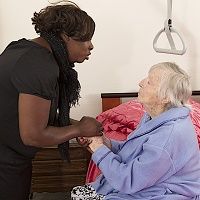Article
Significant Others Play Significant Role for Patients with Chronic Musculoskeletal Pain
Author(s):
A recent study looked at the role that family members can play in supporting those with chronic musculoskeletal pain to remain at work, including some novel insights into how effective and important this encouragement can be.

Patients with chronic musculoskeletal pain (CMP) may find it difficult to pursue what many consider normal activities—including going to work every day. Most clinicians agree that maintaining employment is generally good for pain patients.
An interesting new study in BioMed Central Family Practice looked at the role that family members can play in supporting those with CMP to remain at work, including some novel insights into how effective and important this encouragement can be.
Related research has shown that CMP can be influenced by environmental factors, with an important source being the interaction between the pain sufferer and their “significant other.” Much of that researchhas focused on the potential negative role partners can play. But some recent research has shown that a partners’ support can go beyond simply staying at work to reducing potentially detrimental pain behaviors such as abusing medication. Unique to this study was the focus on those significant others, as opposed to earlier studies that collected data from the pain patients themselves or the observance by clinicians of the supporters’ behaviors.
Qualitative data collected from unrelated studies of both working patients with CMP and their significant others in the United Kingdom and the Netherlands were assimilated. Both of those studies were focused on understanding the lived experience of working with CMP and how wider social circumstances could influence work participation. Both studies relied on semi-structured interviews with open-ended questions, including queries like, “Could you tell me about anything your significant other does to help you manage your condition and stay at work?”, and “Are there any ways in which your significant other is unhelpful in this respect?” Significant others were also asked these questions, but wording was changed to relate to their perceptions and experience.
<!--page-->
Findings from the data
According to the study authors, “None of the workers in either study indicated that their significant others were unhelpful in any way, and all acknowledged their support in helping them to manage their pain and stay at work. All participants referred to help with everyday activities, but the responses revealed that emotional support, encouragement, and participating in joint activities were seen as crucial by both workers and significant others. Thus, three main themes were established: ‘connectivity;’ ‘activity;’ and ‘positivity.’”
In brief, the CMP patients believed that having understanding from someone at home was important. Significant others suggested that maintaining communication about the pain and being a good listener seemed to be effective at helping the patient cope. Importantly, many of the significant others revealed their anxiety about the pain patients unwillingness to discuss their pain. Yet, even those pain patients who didn’t want to talk about their pain found great importance in their loved ones’ encouragement. Both patients and supporters found joint activities to be beneficial, for both encouragement in the activity itself, but also as a means of “just doing something” that had a tendency to carry over to other activities.
Study limitations include the fact that the study’s goals were not the central theme of the original research, the fact that two different studies were combined, and the small sample size, which means the results cannot be generalized. But the authors note that all of the researchers from the current study were involved with one of the original two studies and were sensitive to the context of the work.
The authors conclude, “These findings add to the under-represented ‘social’ dimension of the biopsychosocial model currently applied to our understanding and treatment of pain, and point to harnessing support from significant others as a potentially effective management strategy.”




